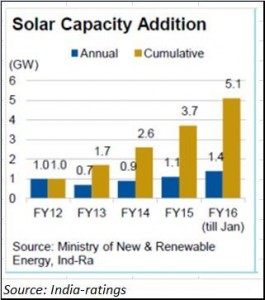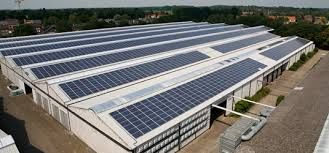http://www.freepressjournal.in/how-will-india-fund-its-solar-power-plans/840358
How will India fund its solar power plans?
Modi’s electoral survival will require more jobs to be created. Rooftop solar could offer a solution.
India faces a huge problem. It may not have the money or the ability to set up its targeted solar power capacity. It can cope with both, but only if it changes its entire approach to solar power.
The origins lie in Prime Minister Modi’s decision to get India to set up 100 GW of solar power capacity by 2022 (http://www.freepressjournal.in/indias-expensive-solar-power-birth-pangs/674987). And while it is true that the annual incremental solar power capacity creation has jumped from 1.1 GW to 1.4 GW, it is still a far cry from the 100 GW the government wants to set up. It has yet to set up 95 GW more (see chart).
 That will cost money. Lots of money.
That will cost money. Lots of money.
According to the Central Electricity Regulatory Commission (CERC), solar capacity creation could cost around Rs.5 crore per MW. That means India will need to find Rs.4,50,000 crore more assuming that 90 GW of incremental capacity has to be set up. Even assuming that solar power installation costs fall to half this level (http://asiaconverge.com/2016/04/crashing-prices-india-can-gain-immensely-solar-power-space/), finding Rs. 2.5 lakh crore won’t be easy. It will have to compete with the other infrastructural costs the government will have to bear on roads, railways, bridges etc.
But the biggest hurdle will be the ability to find land. After all, much of the existing 5 GW of solar capacity has been set up on large tracts of land. Solar farms may seem a convenient way to generate power, but given India’s large population, land availability is proving to be increasingly difficult with each passing year. The penchant for clearing solar farms has also given rise to the suspicion that the government has colluded with some very powerful promoters to grab vast tracts of land.
Therefore, finding the cash will be tough. Finding land for solar farms will be even tougher.
Does this mean that the government’s solar plans will come a cropper?
Not really. Not if it decides to promote rooftop solar aggressively. After all, rooftop solar does not require additional land. That is one problem solved right away.
Also remember, India has a population of 1.2 billion people. Assuming 5 people to a family, that number translates into 250 million families. Yes, it is true that almost 30% of these families do not have a roof over their heads. And almost 20% stay in building where many families have a common roof. Some families stay as joint families as well. Even then, it would leave around 100 million families (or its equivalent) which can partly finance the creation of rooftop solar power capacity. If each family were to chip in around Rs.1 lakh, solar rooftop could get around Rs.10 lakh crore, or four times the required capital cost. Not impossible. Not unreasonable. Add to this land the rooftop potentioal of commercial complexes, factories, schools, colleges and hospitals. There is enough rooftop for solar.
But why should anyone allow solar power capacities to come up on their rooftops unless they could benefit in some way. They would be interested if they could themselves use the power generated – expected to cost Rs.4/ kWh – instead of paying Rs.6-12 for power supplied through the grid. But if the government does not get this higher tariff of Rs.6-12 per kWh, it won’t have the money to finance the subsidised power (at Rs.1.20 / kWh) that farmers and economically weaker section (EWS) households get.
The solution? The government should try and meet the subsidy costs in other ways.
First, it will have to reduce the power losses that run into thousands of crores of rupees. Much of this loss is on account of power theft.
Second, it will have to introduce proper metering for each farm and EWS household. Currently, a goo0d part of agricultural power is used by industry and is only mis-declared as agricultural consumption. Vindication of this belief can be found in the way Maharashtra has — on paper — more pump-sets per acre than the rest of the country. Some of the power that is allegedly being used for agriculture is obviously being used for non-agricultural purposes.
A good way to minimise mis-declaration and theft is by introducing uniform power tariffs. Since the average tariff for the state of Maharashtra is around Rs.5.50 per kWh, each consumer will have to pay that price for power. Of course, they can get the subsidy amount back into their Aadhar linked account. This way, theft becomes difficult, as it must be paid for at market rates; mis-declaration becomes even more difficult to justify at the time of claiming a refund.
But doing this will require political will and guts.
But there is a silver lining. Going by Germany’s example, rooftop power – installation, maintenance and aggregation – creates many more jobs that had been imagined earlier (http://www.firstpost.com/business/what-india-could-not-learn-from-germanys-hermann-scheer-solar-power-model-2749400.html). Today, Germany employs more people in the solar industry than in the engineering and automobile industries.
India has two things that Germany does not have. It has many more young people, most of them desperately seeking jobs. And it has more sunshine. If solar power makes sense for Germany, it makes that much more sense for India. It creates jobs. And it reduces India’s hydro-carbon import bills.
One of the things Modi desperately needs to do is to create jobs. If he fails on this front, winning the next elections will be difficult. Solar power allows him to create many more jobs. Almost overnight.
Solar power also allows him to set up decentralised power generation centres for small population clusters. It can bring electricity even to the remotest villages. A combination of solar power generation by daylight, and power through methane (from waste to energy plants) by nightfall could give Modi the electoral advantage of providing power to the remotest village in India.
Prime Minister Modi may need these special advantages before India goes to the hustings soon.
So will the government finally move in this direction?





































COMMENTS